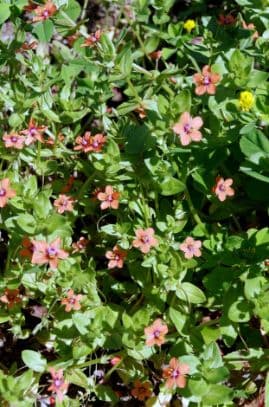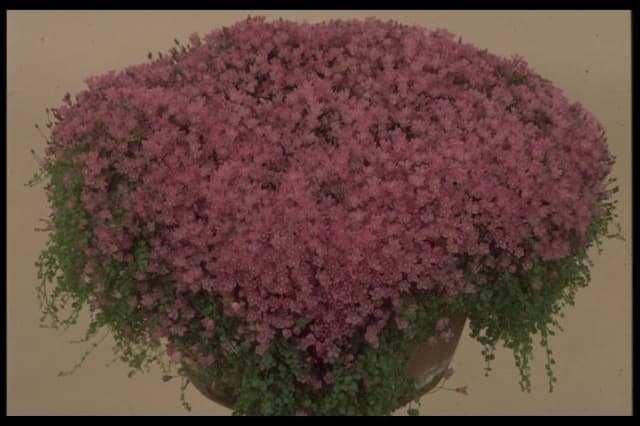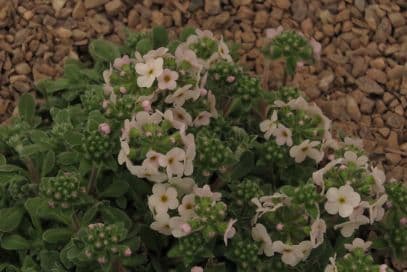Inverewe Polyalthes Primula 'Inverewe' (Pf)

ABOUT
Primula 'Inverewe' is a visually appealing plant that captivates with its vibrant and lush appearance. The foliage consists of a rosette of deep green leaves that provide a luscious background for the striking flowers it produces. Each leaf is rounded with a textured surface, which adds to the tactile beauty of the plant. The blossoms of Primula 'Inverewe' are its most notable feature, showcasing a bright and fiery shade of orange-red. These eye-catching flowers are arranged in clusters atop sturdy stems that rise above the foliage, creating a colorful display that is hard to miss. Each individual flower consists of a funnel-shaped structure with a small, yellow center that provides a delightful contrast to the orange-red petals. The flowers exude a subtle charm and can be appreciated for their delicate arrangement, where they appear to float above the green leaves, almost like vibrant lanterns. The bold coloring of the blossoms ensures that Primula 'Inverewe' is a standout in any garden setting, providing a pop of color that can liven up the landscape. While this description has avoided explicit mention of the size dimensions, it's worth noting that Primula 'Inverewe' possesses a compact and neat growth habit, which makes it suitable for a variety of garden spaces and arrangements.
About this plant
 Names
NamesFamily
Primulaceae
Synonyms
Inverewe Primrose, Scottish Primrose
Common names
Primula 'Inverewe'
 Toxicity
ToxicityTo humans
Primula, commonly known as primrose, is generally considered safe and not toxic to humans. However, some individuals may experience contact dermatitis when handling the plant due to the presence of primin, a known skin irritant found in some Primula species. If ingested, primrose is typically not poisonous, but some individuals with sensitive stomachs might experience mild gastrointestinal upset. It is not common for primrose to cause severe symptoms if ingested by humans.
To pets
Primula, or primrose, is also not typically considered toxic to pets. While most pets that ingest primrose should not experience any serious symptoms, there is a possibility of mild gastrointestinal upset, such as nausea or diarrhea, similar to humans. It is always best to monitor your pet and consult a veterinarian if you notice any unusual behavior after ingestion.
 Characteristics
CharacteristicsLife cycle
Perennials
Foliage type
Evergreen
Color of leaves
Green
Flower color
Orange
Height
6 inches (15 cm)
Spread
12 inches (30 cm)
Plant type
Herb
Hardiness zones
8
Native area
Europe
Benefits
 General Benefits
General Benefits- Attracts Pollinators: The bright flowers of Primula 'Inverewe' can attract bees, butterflies, and other beneficial insects.
- Aesthetic Appeal: With its vibrant orange-red blooms, it adds color and beauty to gardens and landscapes.
- Low Maintenance: Generally easy to care for, requiring minimal upkeep once established in the right conditions.
- Spring Blooming: As a spring bloomer, it provides early season interest after a long winter.
- Container Gardening: Suitable for growing in pots, this allows it to be placed on patios, balconies, or small spaces.
- Edging Plants: Can be used along borders or pathways for a neat, organized look in garden design.
- Groundcover: When planted in groups, Primula 'Inverewe' can form a dense ground cover, suppressing weeds and reducing soil erosion.
 Medical Properties
Medical PropertiesThis plant is not used for medical purposes.
 Air-purifying Qualities
Air-purifying QualitiesThis plant is not specifically known for air purifying qualities.
 Other Uses
Other Uses- Floral Artistry: Primula 'Inverewe' can be used in floral arrangements to add a vibrant pop of color and unique form, particularly in spring-themed displays.
- Educational Tool: These plants can be used in educational settings such as schools and botanical gardens to teach about plant biology and hybridization methods.
- Photographic Subject: Due to their striking colors, Primula 'Inverewe' can be a great subject for photographers specializing in plant and flower photography.
- Bee Garden Plant: Primulas can contribute to a garden focused on attracting and supporting bees and other pollinators with their early blooming flowers.
- Container Gardening: Well-suited for pots and containers, Primula 'Inverewe' can add seasonal interest to balconies and patios.
- Edging Plants: These can be used to create colorful, low-growing edges along paths and garden borders.
- Erosion Control: When planted on slopes, they can help in reducing soil erosion thanks to their compact growth habit and root structure.
- Gift Plants: Due to their attractive appearance and generally non-demanding nature, they make lovely gifts for gardeners and plant enthusiasts.
- Themed Gardens: Primula 'Inverewe' can be used in fairy or miniature gardens to create whimsical settings due to their small size and variety of colors.
- Cold Climate Gardens: They are well-suited for gardens in colder climates as they are hardy and can survive low temperatures.
Interesting Facts
 Feng Shui
Feng ShuiThe Primrose is not used in Feng Shui practice.
 Zodiac Sign Compitability
Zodiac Sign CompitabilityThe Primrose is not used in astrology practice.
 Plant Symbolism
Plant Symbolism- Youthfulness: The Primula 'Inverewe', commonly known as Primrose, is frequently associated with youth and vitality due to its early spring blooming, symbolizing the start of new life and fresh beginnings.
- Eternal Love: Primroses often symbolize eternal love, possibly because they can return each year with their blossoms, representing steadfastness and affection that lasts over time.
- Hope: The bright flowers of the Primrose offer a sense of hope and encouragement, often found in folklore linked to the idea that seeing a Primrose could alleviate despair.
- Novelty and New Experiences: Given the Primrose's role as one of the first flowers to bloom in spring, they can represent striving for new experiences and embracing change with a sense of adventure.
 Water
WaterWater your Primula 'Inverewe', commonly known as 'Inverewe' Polyanthus, thoroughly when the top inch of the soil feels dry. Usually, this translates to watering once or twice a week, but this can vary depending on the climate and the time of year. During hotter seasons or in dryer climates, you may need to water more frequently. The method of watering should be gentle and direct to the base of the plant to avoid wetting the foliage, which can lead to disease. Aim to provide approximately half a gallon of water per square foot every week, adjusting as necessary for rainfall and temperature conditions.
 Light
Light'Inverewe' Polyanthus prefers bright, indirect light. An ideal spot would be a location where it receives morning sunlight and afternoon shade. Avoid exposing the plant to prolonged direct sunlight, especially during the hot afternoon hours, as this can cause leaf scorching.
 Temperature
Temperature'Inverewe' Polyanthus thrives in cooler temperatures and can tolerate a range from 40 to 75 degrees Fahrenheit. The ideal temperature range for this plant is between 60 and 70 degrees Fahrenheit. It's essential to protect the plant from temperatures above 80 degrees Fahrenheit, as excessive heat can have adverse effects on its growth and flowering.
 Pruning
PruningPrune your 'Inverewe' Polyanthus to remove dead or faded flowers, a process known as deadheading, which encourages additional blooms. Also, trim back any damaged or diseased foliage to maintain plant health and appearance. The best time for pruning is after the main flowering period, usually in late spring or early summer. Prune yearly, or as necessary, to keep the plant tidy and promote vigorous growth.
 Cleaning
CleaningAs needed
 Soil
SoilThe Scottish Primrose requires well-draining soil mixed with peat moss or compost to retain some moisture. A slightly acidic to neutral pH of 6.0 to 7.0 is ideal for healthy growth. For best results, use a mix of one-third garden soil, one-third peat/compost, and one-third perlite or vermiculite.
 Repotting
RepottingPrimulas, including the Scottish Primrose, should be repotted every one to two years to refresh the soil and provide room for growth. It is best to repot in the spring just before active growth begins.
 Humidity & Misting
Humidity & MistingScottish Primrose thrives in moderate to high humidity levels. Aim to maintain humidity between 50-70% for optimal growth, as this mimics their native damp environments.
 Suitable locations
Suitable locationsIndoor
Provide bright, indirect light and keep evenly moist.
Outdoor
Plant in partial shade and protect from afternoon sun.
Hardiness zone
4-8 USDA
 Life cycle
Life cyclePrimula 'Inverewe', commonly known as the Inverewe primrose, typically begins its life cycle when seeds are sown in moist, well-drained soil during late winter or early spring in a cold frame or greenhouse. The seeds germinate, and seedlings emerge, which are then pricked out and grown in individual pots once they are large enough to handle. After a period of growth, the young plants are hardened off before being transplanted outdoors into their final position in partial shade to full sun during late spring or early summer. The Inverewe primrose produces rosettes of leaves and bright, colorful flowers primarily in spring and early summer, though some blooming may continue intermittently throughout the summer. Once flowering is complete, the plant sets seed, which can be collected for propagation or allowed to self-sow. Throughout its life, annual maintenance such as deadheading to prolong flowering, division of clumps every few years to maintain vigor, and protection from slugs and snails is necessary to ensure the long-term health and flowering of the plant.
 Propogation
PropogationPropogation time
Spring-Early Summer
Primula 'Inverewe', also known as Primrose, is typically propagated by division, which is the most popular method for this plant. The best time to divide Primrose is in the late summer or early fall, after the blooming period has ended. This allows the plant to establish itself before the onset of winter. To propagate by division, carefully lift the parent plant from the ground, making sure to retain as much of the root system as possible. Using a sharp, clean knife or spade, divide the clump into smaller sections, each containing a few leaves and a portion of the root system. Replant these divisions at the same depth they were growing before, spacing them about 6 to 12 inches (15 to 30 centimeters) apart to give them room to grow. Ensure they are watered well after planting to help establish the new plants.









